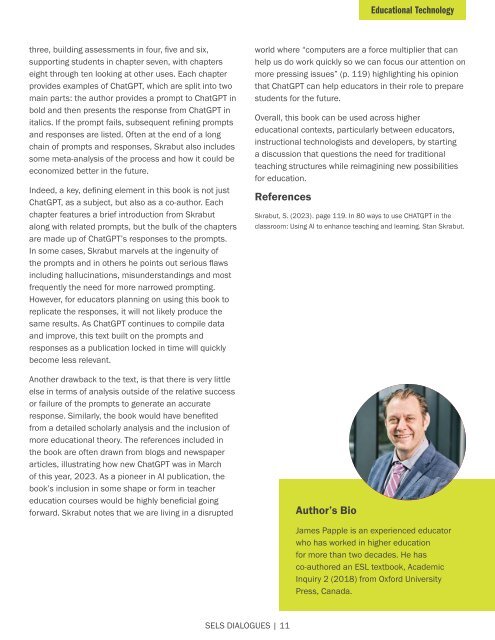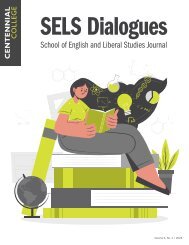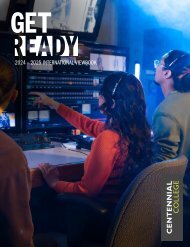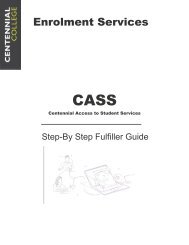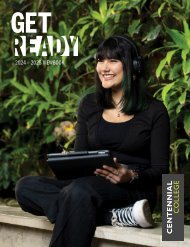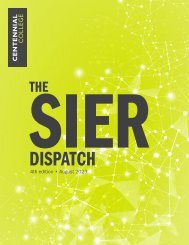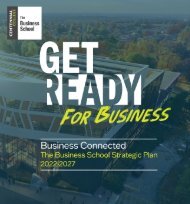SELS Dialogues Journal Volume 3 Issue 1
A diverse collection of articles, each offering a unique perspective and contributing to the ever-expanding landscape of knowledge and creativity.
A diverse collection of articles, each offering a unique perspective and contributing to the ever-expanding landscape of knowledge and creativity.
Create successful ePaper yourself
Turn your PDF publications into a flip-book with our unique Google optimized e-Paper software.
Educational Technology<br />
three, building assessments in four, five and six,<br />
supporting students in chapter seven, with chapters<br />
eight through ten looking at other uses. Each chapter<br />
provides examples of ChatGPT, which are split into two<br />
main parts: the author provides a prompt to ChatGPT in<br />
bold and then presents the response from ChatGPT in<br />
italics. If the prompt fails, subsequent refining prompts<br />
and responses are listed. Often at the end of a long<br />
chain of prompts and responses, Skrabut also includes<br />
some meta-analysis of the process and how it could be<br />
economized better in the future.<br />
Indeed, a key, defining element in this book is not just<br />
ChatGPT, as a subject, but also as a co-author. Each<br />
chapter features a brief introduction from Skrabut<br />
along with related prompts, but the bulk of the chapters<br />
are made up of ChatGPT’s responses to the prompts.<br />
In some cases, Skrabut marvels at the ingenuity of<br />
the prompts and in others he points out serious flaws<br />
including hallucinations, misunderstandings and most<br />
frequently the need for more narrowed prompting.<br />
However, for educators planning on using this book to<br />
replicate the responses, it will not likely produce the<br />
same results. As ChatGPT continues to compile data<br />
and improve, this text built on the prompts and<br />
responses as a publication locked in time will quickly<br />
become less relevant.<br />
Another drawback to the text, is that there is very little<br />
else in terms of analysis outside of the relative success<br />
or failure of the prompts to generate an accurate<br />
response. Similarly, the book would have benefited<br />
from a detailed scholarly analysis and the inclusion of<br />
more educational theory. The references included in<br />
the book are often drawn from blogs and newspaper<br />
articles, illustrating how new ChatGPT was in March<br />
of this year, 2023. As a pioneer in AI publication, the<br />
book’s inclusion in some shape or form in teacher<br />
education courses would be highly beneficial going<br />
forward. Skrabut notes that we are living in a disrupted<br />
world where “computers are a force multiplier that can<br />
help us do work quickly so we can focus our attention on<br />
more pressing issues” (p. 119) highlighting his opinion<br />
that ChatGPT can help educators in their role to prepare<br />
students for the future.<br />
Overall, this book can be used across higher<br />
educational contexts, particularly between educators,<br />
instructional technologists and developers, by starting<br />
a discussion that questions the need for traditional<br />
teaching structures while reimagining new possibilities<br />
for education.<br />
References<br />
Skrabut, S. (2023). page 119. In 80 ways to use CHATGPT in the<br />
classroom: Using AI to enhance teaching and learning. Stan Skrabut.<br />
Author’s Bio<br />
James Papple is an experienced educator<br />
who has worked in higher education<br />
for more than two decades. He has<br />
co-authored an ESL textbook, Academic<br />
Inquiry 2 (2018) from Oxford University<br />
Press, Canada.<br />
<strong>SELS</strong> DIALOGUES | 11


